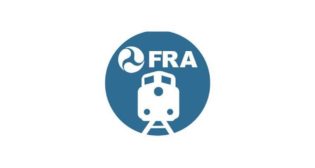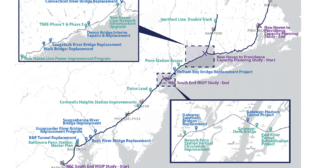
America without Greyhound—and no replacement passenger trains
Written by David Peter Alan, Contributing EditorWe are not usually concerned with buses at Railway Age, but what would happen if Greyhound buses suddenly disappeared from American roads, and Amtrak became the only provider of passenger transportation with a nationwide reach? That speculation is not as far-fetched as it would appear at first blush, as a similar scenario is being played out at this writing in much of Canada.
Many Amtrak riders, whether they use its corridors, long-distance trains or both, are concerned about the future of “America’s Railroad.” Some have blamed current Amtrak President and CEO Richard Anderson for the railroad’s woes, while others have not gone that far. It is undisputed that Amtrak has been in trouble before, and has usually limped along throughout its history of nearly 48 years. It is also undisputed that the nation’s long-distance train network has not changed much since Amtrak began life in 1971, and it has certainly not grown substantially. Most of the network’s growth has resulted from involvement of states like Illinois, California, Washington and others, and the efforts by those states to develop the state-supported corridors that have become popular since the 1990s.
While the threat to the national Amtrak network is genuine, and it could come either from inside or outside the Amtrak organization, there are advocates at the Rail Users’ Network (RUN), the Rail Passengers’ Association (RPA) and state and regional organizations that will fight to keep their trains on the rails and the skeletal Amtrak network intact.
There is a threat to another component of our non-automobile mobility that is not as well-known: the potential demise of Greyhound, the country’s largest national-level bus carrier. Greyhound buses run up and down both coasts, across the South, and through mid-latitude parts of the nation. They do not operate in the northern latitudes, from the Midwest to just short of the West Coast; that is the domain of Jefferson Lines. There are also some remnants of the old Trailways network: Burlington Trailways in the Midwest, Adirondack Trailways in New York State, and a few others. Still, Greyhound operates the vast majority of the intercity bus service in America.
Greyhound keeps going with a fleet of about 1,100 buses; less than one-third the number it operated in 1983. Since then, the company has endured strikes, bankruptcies and a number of ownership changes. It continues to operate relatively frequent service on a number of routes (often parallel to Amtrak routes), and sporadic service (often only once per day) on many others. It keeps going, but its operation could not reasonably be described as stable, over the long run. It is actually meta-stable. The company can keep going for now, but it highly questionable whether it can afford to replace its fleet as buses wear out. So, whether the Greyhound we know today will be recognizable five years from now is anybody’s guess. Greyhound does not have advocates like the trains do, either.
On Feb. 8, regional bus carrier Carl Bieber Transportation of Kutztown, Pa., bit the dust. The company suddenly announced that service would end that day, even leaving monthly ticket holders with 14 commuting days to go and no more buses to Philadelphia or New York City. The college town of Kutztown and the struggling, medium-sized city of Reading are now left without intercity buses. Could that happen to “The Hound”? The answer is “Some day, maybe,” and that is bad enough. Millions of riders would lose their buses. Who would step in and fill the void? Would elected officials rush to form “Ambus” or a bus entity similar to Amtrak? Would Amtrak run more trains to accommodate former bus riders with nowhere else to go? Or would these people just be stranded?
The answer might lie to the north, in Western Canada, where such a scene is being played out now.
On July 10, 2018, Greyhound Canada shocked the nation by announcing that all bus service east of Quebec City and west of Sudbury, Ontario (about a seven-hour trip west of Toronto) would be discontinued on October 30. The company would continue to operate in Ontario and Quebec, including near the corridors operated by VIA Rail. Regional bus carriers were not affected. Orleans Express still operates in northern Quebec. Maritime Bus still runs skeletal service in Atlantic Canada, mostly along the routes of VIA’s tri-weekly Ocean (originally Canadian National) and the long-discontinued Atlantic Limited (originally Canadian Pacific). There are a few other routes left, too.
The situation is far-worse in Western Canada. Greyhound USA still operates between Vancouver and Seattle, but so does Amtrak. The only long-distance passenger train operated by VIA Rail, the Canadian, operates only twice each week between Toronto and Vancouver, through Winnipeg, Saskatoon and a point several miles north of Edmonton, on the CN main. The original Canadian route through Regina and Calgary, on the CP main, has not hosted a scheduled passenger train since 1990. Only the privately operated luxury “cruise train,” the Rocky Mountaineer, operates on part of the line, and it is not suitable for point-to-point transportation.
When the demise of Greyhound Canada’s western service was announced, the Canadian Broadcasting Corporation (CBC) and other media reported that regional bus carriers were looking to fill the void. It was reported that Saskatchewan-based Rider Express would run buses from Calgary, Regina and Winnipeg to Toronto. Those buses never ran. Today, more than three months after Greyhound pulled out of the region, Rider Express runs two buses a day between Regina and Saskatoon, one bus six times a week between Saskatoon and Edmonton, service to a few other communities, and a bus that runs from Calgary to Vancouver on Fridays, which returns to Calgary on Saturdays. There is still service between Calgary and Edmonton in Alberta, and some regional service in British Columbia.
Kasper Transportation operates a few routes (nothing more than once per day) in the Thunder Bay region of western Ontario; two buses from Winnipeg: a daily bus to Sioux Lookout (on VIA Rail’s Canadian route); and a tri-weekly bus to Thompson (on VIA Rail’s Hudson Bay route). I do not know of any other intercity buses that serve Winnipeg. VIA Rail operates trains from that city to Toronto, Vancouver and Churchill in the extreme north of the province, all twice-weekly.
In short, whatever talk there may have been about Canada’s federal or provincial governments stepping in and ensuring that ordinary Canadians will have a bus to ride, nothing has happened, not yet, at least. Until last year, VIA Rail ran its Canadian on a tri-weekly schedule from May through October. Yet, even with hardly any buses running parallel to parts of the route, there are no plans to restore the three-times-weekly runs next summer, except between Vancouver and North Edmonton.
Nobody is “stepping up to the plate” about buses, either. The Liberal government in Ottawa under Prime Minister Justin Trudeau does not seem to care. The New Democratic Party (NDP), whose ideology is similar to that of the “Progressive” wing of the Democratic Party in the U.S., holds governing majorities in the Provinces of Alberta and British Columbia. Still, there are few buses operating in those provinces since Greyhound Canada pulled out last fall.
So where does that leave us in the U.S.? In this writer’s opinion, it would leave us where western Canada stands today.
Would Amtrak expand service to accommodate riders who have lost their buses? That seems highly unlikely. Before Amtrak was founded as part of the Rail Passenger Service Act of 1970, private-sector freight railroads were discontinuing passenger trains as quickly as they could through the Interstate Commerce Commission (ICC). One of Amtrak’s primary tasks was to discontinue routes quickly, without need for the administrative proceedings required under ICC jurisdiction.
Many at the time mistakenly believed that Amtrak’s actual purpose was to hasten the total demise of passenger trains throughout the nation. It wasn’t. It was to relieve the freight railroads of their obligation as common carriers to operate passenger services, which were huge money-losers. Many Americans remained loyal to the few passenger trains left, and the Amtrak network has stayed about the same size over the years, with its limited growth concentrated among state-supported trains and corridors.
Given its record and calls by Amtrak President Richard Anderson for the end of daily service on Amtrak’s western Chicago-California transcontinental trains, the California Zephyr and Southwest Chief, it is difficult to fathom that Amtrak would suddenly add routes and frequencies to accommodate displaced bus riders. Even if a new Amtrak management wished to take such a step, the railroad does not have nearly enough equipment to expand its network. To make matters worse, some displaced Greyhound riders would switch to Amtrak, which would add to the stress on Amtrak’s already-limited system capacity. A few Greyhound runs are designated as “Amtrak Thruway” connecting buses, but it is not clear that these connections with Amtrak would survive if Greyhound shut down. It is unclear whether Amtrak would save those specific runs by contracting with other carriers.
It seems highly unlikely that government entities in this country would keep the nationwide bus system going. The Trudeau Administration in Ottawa espouses policies far more liberal than those of the Trump Administration in Washington, but Ottawa has not acted to fill the gaps in bus service that the demise of Greyhound Canada, especially west of Ontario, has created. If it did not happen there, it probably will not happen here. There have been few instances where small private-sector or public-sector carriers have stepped in and continued a specific U.S. route that Greyhound abandoned.
For now, Amtrak and Greyhound both operate nationally, but not on a basis that can be considered stable for the long-term. For the moment, at least, Amtrak provides useful transportation on its entire system every day, with the exception of two tri-weekly routes, the Cardinal and Sunset Limited. It even provides daily service between Toronto and Vancouver, with Maple Leaf, Lake Shore Limited, Empire Builder and Cascades trains. The trip requires changing trains in Buffalo, Chicago and Seattle, and it takes 76 hours—but it’s 19 hours faster than going from Toronto to Vancouver on the Canadian, and the cost is lower. The experience is different, too, but service is available every day, not merely twice per week. Frequent VIA Rail corridor service between Montreal and Toronto (about five hours) and Ottawa and Toronto (about four hours) makes it possible to travel by rail from Quebec province and Canada’s capital city to Vancouver.
How long will the current Amtrak network remain intact? That is anybody’s guess, as is the future of Greyhound. One major difference is that Amtrak has advocates pushing for it, while a large number of elected officials, in Congress as well as at the state and local levels, are fighting to keep it going, too. There are no comparable “bus advocates” pushing to keep the long-distance buses going.
So, in a few years, many American long-distance bus riders may come to the sad conclusion that their counterparts to the north have reached: You can’t get there from here anymore.



